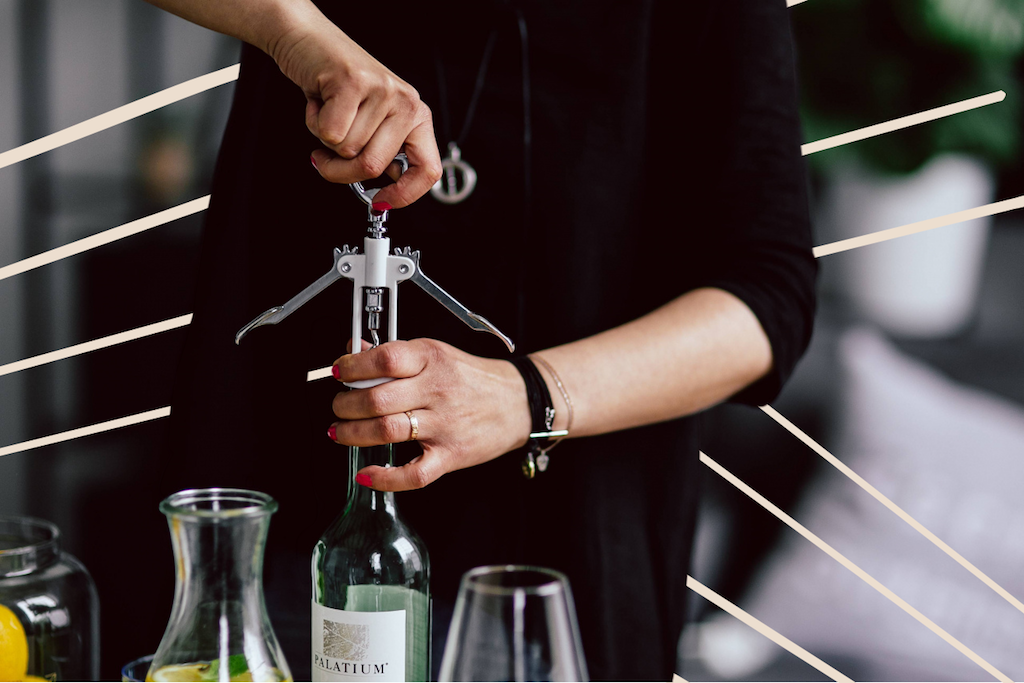Compulsive viewers of ITV’s fabulous food and romance reality show Dinner Date will be all too familiar with the recurring scene; a gentleman suitor fumbles and fusses over uncorking a wine bottle, apparently having chosen national TV as their first time to try.
The cork is broken in half, crumbled and pushed into the wine, or popped violently and at full tilt, with claret ending up all over pristine white carpet.
Whilst it’s certainly surprising just how common an occurrence this is, there’s no denying that there’s an art to this thing, and with the correct tekkers and form, you’ll not only save yourself embarrassment, but also avoid spilling or tainting your wine. So, here are a few pointers on opening a bottle of wine.
BUY THE CORRECT TOOLS
To perfect any technique, you must invest in the right tools for the job. There are two main items you need to crack open your favourite bottle of wine; a strong and sturdy corkscrew, and the best wine foil cutter you can find.
Alternatively, you might prefer to condense the necessary items into one homogeneous tool, known as a waiter’s corkscrew, which boasts a foil cutter (which looks like a small blade), lever and worm (the spiral element that enters the cork). For many, these are much easier to use efficiently than a winged corkscrew, the latter of which doesn’t boast a wine foil cutter.
TO SCREW OR NOT TO SCREW?
Before you go straight in with your corkscrew or any other tools for that matter, make sure to check the bottle you’re going to be using. This is because not all bottles come sealed with a cork; sometimes there might be a screw cap beneath the foil, and you don’t want to push your corkscrew into that!
This might sound too obvious, but many people start using the corkscrew on their bottles, only to find out that there wasn’t a cork there to begin with; an easy mistake if you have guests and are opening another bottle!
Whilst we’re on the subject, let’s dispel a common misconception; a screw top doesn’t necessarily denote a lesser quality of wine. Increasingly, premium winemakers are choosing to use screw caps, particularly for wines that are intended to be enjoyed ‘young’. Since screw tops are better for keeping any oxygen from entering the bottle, they are generally considered ideal for retaining a crisp finish on certain styles of wine.
On the flip side, full-bodied wines naturally benefit from a little oxygen entering the bottle, which a traditional cork facilitates.
Of course, the ritual of the uncorking is one of wine’s prefatory pleasures, with the effort, the action, the sound and the anticipation all adding to the final drinking experience.

BEGIN CUTTING THE FOIL
This should be fairly easy, right? Once again, not quite so. A common mistake that people make is they cut the foil that sheaths the wine’s neck (often referred to as the ‘capsule’) in the wrong place. First, you need to find the lip at the very top of the bottle. This is hard to miss – it’s the bulge of the bottle at the neck.
Now, where do you cut? Cutting at either the bottom or top of the lip is incorrect. By cutting in this way, you run the risk of the wine coming into contact with the foil when you serve it, which is unhygienic and potentially detrimental to its flavour.
The best place to start cutting your foil is either in the middle of the lip or right at the bottom of the ring (where the ring and the neck join). In both cases, you should only remove the top part, not the entirety of the capsule, since in formal service, the capsule is considered part of the wine’s packaging, and can be used as an identifying tool to discern the wine’s origins.
USE THE CORKSCREW TO REMOVE THE CORK
With the foil out of the way, you’re one step closer to tasting that fresh, crisp wine waiting for you in the bottle. Fetch your corkscrew and begin removing the cork by inserting the spiral into the centre of the cork. All you have to do is push and rotate the spiral; stop when you are about 6 and a half turns in.
At this point, you should be able to see only one curl of the screw showing. Depending on the type of corkscrew that you’re using (for example, the waiter’s friend, a winged corkscrew or a lever opener), there are different ways to gently pull out the cork. Check out how the lever on your specific type of corkscrew is meant to be used to avoid any mishaps. In our experience, a waiter’s friend removes the cork more cleanly, with a winged corkscrew sometimes causing a little abrasion as it leaves the neck of the bottle.

CHECK IF THE WINE IS CORKED BEFORE SERVING
It’s not quite time to pour the wine yet! Before you start serving wine to your guests (or yourself), you should always check that it’s in good condition, which basically means, if it’s corked.
Contrary to popular belief, being ‘corked’ doesn’t indicate that there are bits of cork mixed into the wine or that you have a bad cork. The term ‘corked’ is normally used to describe a situation where the cork has become contaminated with bacteria and thus, has spoiled the wine.
How can you tell if your wine is spoiled or not? The method is fairly simple. All you will have to do is smell the cork that you’ve just removed from the bottle. The cork should smell like fresh wine. You will know if your wine has been corked if the cork smells like mold or wet cardboard. In that case, you should not serve the wine.
Sometimes, you might not be able to smell mold or wet cardboard. In some cases, it might have a very strong scent of cork. Cork does have a characteristic smell, which is usually very faint or is overpowered by the smell of wine that rubs onto it. Simply put, if it smells of too much cork and little or no smell of wine, then the cork was contaminated at some point, and therefore, the wine cannot be served.
Interestingly, wine that has been bottled using a screw top can also be ‘corked’. As the experts at Wine Spectator explain, ‘’a screw-capped wine can still be “corked.” It’s possible for the chemical TCA (2,4,6-trichloroanisole) and its corky, nasty odors of musty, damp cellars and wet newspapers to affect a winery’s entire cellar, ruining whole batches of wine—which can then be topped with a screw cap.’’
That said, your chances of running into a ‘corked’ wine from a screw-topped bottle are much lower than from a bottle which has used a traditional cork.
SAVOUR THAT FIRST SIP
Once you have successfully removed the foil, taken out the cork and done your quality check, the last step is to pour and serve the wine. And, of course, enjoy it!
Oh, you thought this thing was over? The storing of your wine is equally as important. Fortunately, we’ve covered all of that over here. Do check it out.





